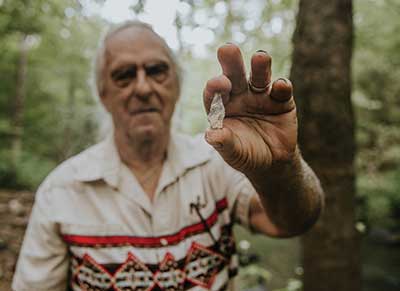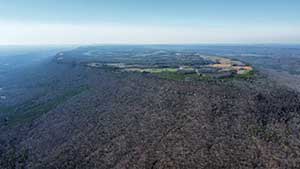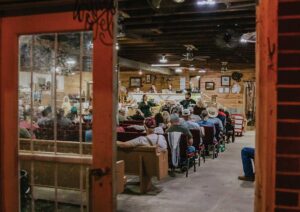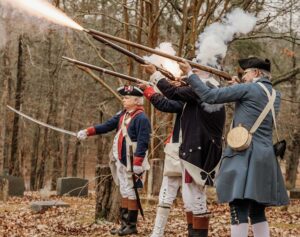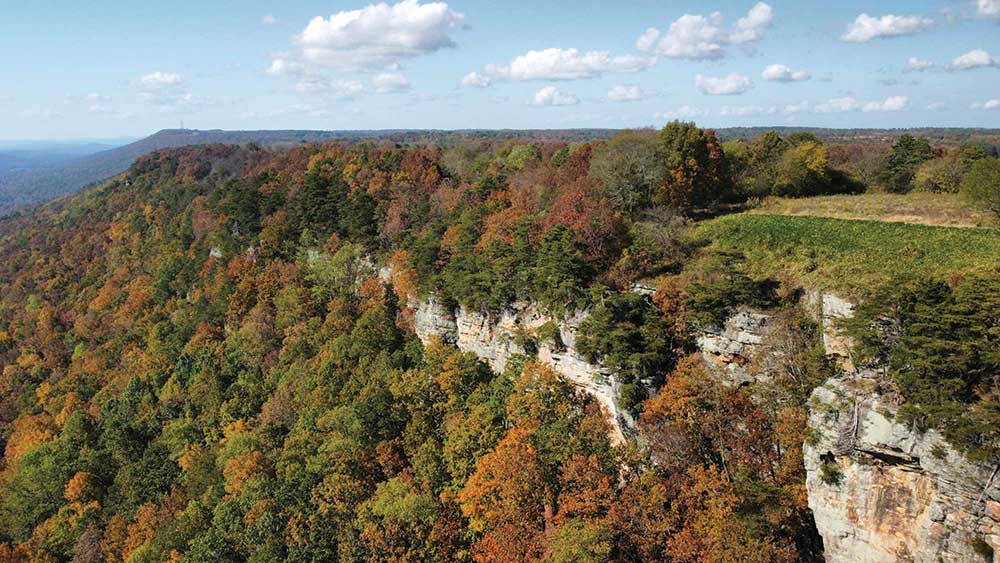
Once historic enemies join forces to keep a proposed dam project off the mountain
Story by Paul South
Photos by Mackenzie Free and Leo Galleo
When Seth C. Penn ponders Chandler Mountain, he thinks of the Indigenous peoples who walked the mountaintop 6,000 years before Christ trod the earth.
Darrell Hyatt thinks of generations of his family, who yanked a living from the mountain’s rich soil. The Hyatts came to the area when the only way to navigate the mountain was by wagon, horseback or on foot.
And Joe Whitten, an amateur historian and retired educator who came to St. Clair County in 1961, hiked from the base to the top of the mountain at age 80 and plans to do so again, even at 85.
Their backgrounds are different, but the three men share a love for the mountain and an understanding of the importance of the successful battle to fend off an Alabama Power proposal to build dams there. It was a plan that would have flooded the valley, displaced families and damaged sacred sites and archaeological treasures.
While bluegrass music at Horse Pens 40 and tomatoes – the area’s iconic signature crop – sprout in the minds of most Alabamians when the name, Chandler Mountain, is mentioned, make no mistake, it is holy ground.
According to Penn, Southeastern Region coordinator for the Indian Nations Conservation Alliance and a citizen of the Cherokee Tribe of Northeast Alabama, all land is sacred for Indigenous peoples, regardless of location. But the mountain is unique.
“Chandler Mountain is an area where tribal territories met,” Penn said. “This was a place inhabited by several different tribes, Cherokee people and Muskogean people as well. This is an area where you could see different looking people, different looking tribes, different languages. That makes the mountain unique unto itself.”
There are archaeological and ecological features on the mountain sacred to the tribes.
“How the water flows, the hydrologic buildup, makeup and processes are important ecologically and also sacred, considering the values of water, plant life and animals,” he said.
Prayers and other ceremonies were conducted on the mountain. And while the story may be apocryphal, it is said that Chandler Mountain is the only place where a peace treaty was signed between the Cherokee and Creek tribes.
“I have never seen that document,” Penn said. “So as far as the credibility of that, it’s very debatable and very questionable. So, my response to that would be, I’d like to see that happen in present time, so that an actual treaty exists.”
One piece of ancient history that does exist are the rock formations, stone structures and Cherokee pictographs, rock art that native peoples may have painted with their fingertips, according to a report by Dr. Harry Holstein, a professor of Chemistry and Geosciences at Jacksonville State University.
These drawings and structures, as well as the stars, all play into the ceremonial and governmental history of the mountain and its ancient inhabitants, Penn said.
“This is a place where we might go to higher ground in search of a spiritual connection. It’s a place where territories met. So, at times we might meet in council-like setting, where topics might be discussed among our tribe or with other tribes even. Trades could also take place,” Penn said.
From a spiritual perspective, he added, “The whole sacred, ceremonial prayer aspect of events that took place – with certain rock features facing certain directions, certain astrological features in line with certain features, that all plays into the ceremonial aspect of it.”
A Family’s Story
With all their earthly belongings, John Hyatt and his wife arrived on horseback from Hurt County, Ga., and settled near the Horse Pens area in 1875, where they homesteaded 120 acres.
“There have been Hyatts on that end of Chandler Mountain ever since,” said John Hyatt’s great-grandson, Darrell.
He lives near the base of the mountain. He can recite his family’s history like a precocious schoolboy. John Hyatt’s brother, Otis, was the first person to farm the tasty Chandler Mountain tomatoes.
But the mountain is about more than tomatoes. Darrell has lived in the Chandler Mountain Valley since 1969, and at his current homestead since 1981. There, he reared his children.
At one time, he pondered moving his family out west. But the tug of home was too strong, the ties too deep. In his family, Darrell has always been known as “the man who came back to the mountain.”
“I always knew this mountain was different,” he said. “We could never pull ourselves away. It’s not just the family history. It goes back thousands of years.”
He found paleo-points on the mountain, and he and his wife found the pictographs. In turn, they brought Holstein as well as a rock expert from the University of Tennessee.
“Dr. Holstein said this was the most significant archaeological find on the upper Coosa River drainage area,” Hyatt said.
That archaeological find played a significant role in the defeat of the Alabama Power project.
What would have been the impact of the project if it had moved forward? Often, before Alabama Power shelved the plan, Darrell imagined his last day in his beloved valley, where his kids grew up and where he walked the mountain, climbed its rocks and contemplated the world in solitude.
One of the dams would have been built within 1,000 feet of his home. Rocky Hollow, the Mount Lebanon Cemetery, a number of archeological treasures and dozens of families would have been washed away.
The Hiker
Darrell remembers the first time he and Joe Whitten hiked the mountain, following Steele Gap Road. Whitten was 80.
“Joe, are you ready to stop?,” he would ask.
“Where’s the top?,” Whitten replied. Hyatt pointed upward.
“Let’s go,” Whitten said. And they did. “I think I can do it again,” he added.
Whitten talks of the importance of Chandler Mountain to the quality of life of St. Clair County and to its economy.
“It was in a remote section of the county that the pioneers made a beautiful place of,” Whitten said. “As time progressed, they tried various fruits. They grew peaches there for a time, but the tomatoes made the mountain famous.”
The Alliance
Two groups that history saw often at odds, the Indigenous tribes and new settlers of the 19th century, joined with the City of Steele and Montgomery politicians to fight the utility. The fight continues because the utility still owns significant acreage there.
In the face of opposition from locals, as well as Public Service Commission President Twinkle Cavanaugh, Alabama Power Company scrapped its plans to build a hydroelectric storage project and remove homeowners from Chandler Mountain in August 2023. The utility withdrew its efforts to seek a license from the Federal Energy Regulatory Commission.
In these politically fractured times, is there a lesson to be learned from the alliance that fought it?
“Absolutely,” Darrell said. “This community in my eyes was starting to lose itself. (The dam project) pulled everybody together.”
In local folklore, it’s told that John Hyatt built the market road down the backside of the mountain near what’s now U.S. 231, in an area known as Hyatt’s Gap. And the mountain can be seen from Alabama’s highest peak, Mount Cheaha.
“It’s very distinct,” he said. “And I think the Native Americans saw that, too. It’s sacred. Very sacred to them.”
Whitten said that even in these difficult days, the successful effort to block the project, “shows there can be unity. Peoples can come together and work together on projects that are needful to the community and the county and the state.”
He added, “What is there is important to the state as well, because it’s part of our Indigenous history.”
Penn agreed. “Obviously, it’s an ancestral holy place for an Indigenous person,” he said. “But because of those thousands of years of prayers building a foundation for a sacred setting, it’s just as much a sacred place for that farmer who says a prayer while he’s out there planting or harvesting. It’s a sacred place to that family who comes together and prays before a meal every time they eat dinner. It’s a sacred place and a significant place to many people.
“While our significance to the mountain and the sacredness of the mountain predates the settlers, I don’t want to discredit that it’s important to many of them as well in present time.”
Of the alliance, Penn said, “We’re a whole lot better when we can put differences aside and find common ground and work together regardless of backgrounds, faiths or political affiliations.
“Chandler Mountain is a unique situation in that we can come together. We have done that, and I’d like to see this initiative grow. I’d like to see Alabama Power realize, ‘Look, we had wrong intentions here. This isn’t where we need to do this. We just need to pull out and let go and give this mountain back to the people who truly care about it. And that is the Indigenous people and that is the local Chandler Mountain Community. That is our mountain and should be our mountain. That’s how I feel about it.”
“Alabama Power does not have any plans for the Chandler Mountain property,” said Alabama Power spokesperson Joey Blackwell in an email response in April.
When Alabama Power announced it had scuttled its proposal, there were celebrations on Chandler Mountain. Hyatt and his family celebrated with dinner at an area Mexican restaurant.
There was joy. “And there were tears,” he said. “More than a few tears.”












